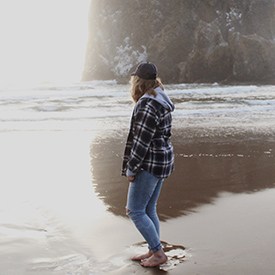The Oregon Coast, being in the Pacific Northwest, is a relatively temperate climate year-round. There is rarely, but occasionally snow in winter and a summer day above the 80s is a bit of a unicorn. Winters are pretty wet, getting upwards of 10” of rain per month in some locations and during the summers it isn’t uncommon to have a marine layer that makes the day start out chilly and foggy. At any time of year, it’s a good idea to have comfortable walking shoes and/or water shoes and you’ll always want to keep the layers available to throw on something a little extra when the sun slips behind its 100th cloud of the day.
WINTER – December, January, February
During the winter at the Oregon Coast, you’re not likely to do any swimming, but you’re still going to get plenty wet. Make sure you have a lightweight weatherproof jacket along with your windproof umbrella. Temperatures will range from the 30s-low 50s and you’re more likely than not to spend at least part of your day in anything from a drizzle to a torrent. Long, or even lined pants are good, and depending on how you handle cold, you may want a base layer as well. This is the time for cozy fleece vests or jackets, flannels, and sweaters. Good hiking boots over your wool socks for the feet and a fluffy beanie for the head will keep you snug while exploring.
SPRING – March, April, May
Oregon Coast spring is a warmer, less rainy version of winter. Temperatures are likely to be in the 40s-60s. Depending on what kind of temps you’re used to, you may be good with either pants or shorts this time of year as well as short or long sleeves, but make sure you still have that weatherproof jacket handy. If your feet don’t get too cold, you might be brave enough to try hiking sandals at this point but probably still want a lightweight beanie to protect your ears from the wind at the beach.
SUMMER – June, July, August, September
Summertime is beautiful along the Oregon Coast! Days will typically reach into the mid-80s with nighttime temps likely to drop into the 50s. Rain is always possible and the wind is pretty much guaranteed, so throw the weatherproof jacket and a beanie into your daypack just in case. You may also want your swimsuit, but keep in mind the water temps in Oregon stay in the 40s-50s all year, so it will be bracing, to say the least! Swimming or not, shorts and short sleeves will be great during summer along with your hiking shoes or sandals.
FALL – October, November
Spring and fall have very similar temperatures so the packing recommendations for spring apply here. Fall typically does have less marine layer though, so you see more sun, which always feels warmer than a cloudy day with the same temp. The later into the fall you go, the more rain you’re likely to encounter, so plan accordingly.






























































